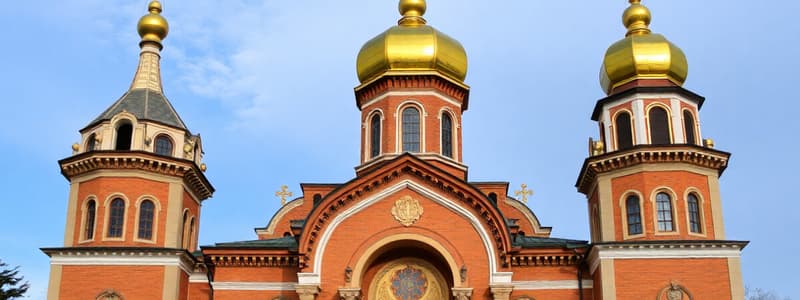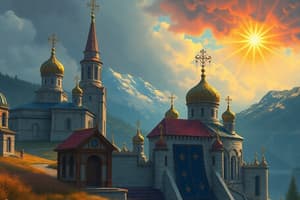Podcast
Questions and Answers
How does the Eastern Orthodox Church primarily maintain its autonomy?
How does the Eastern Orthodox Church primarily maintain its autonomy?
- By adhering strictly to the directives of the Patriarch of Constantinople.
- By appointing a governing body elected by the church's lay members.
- Through its direct affiliation with the Roman Catholic Church.
- Via an independent Council of Bishops, known as a Synod. (correct)
What is the historical significance of Constantinople in relation to the Orthodox Church?
What is the historical significance of Constantinople in relation to the Orthodox Church?
- It is where the tradition of using icons in worship was first developed.
- It was the site where the Orthodox Church first unified with the Roman Catholic Church.
- It was the birthplace of the American Orthodox Church.
- It served as the central location for the Orthodox Church following its split. (correct)
Which term best describes the liturgical classification of the Orthodox Christian Church?
Which term best describes the liturgical classification of the Orthodox Christian Church?
- Evangelical
- Charismatic
- Liturgical (correct)
- Non-liturgical
In the context of an Orthodox Christian funeral, what is the purpose of the 'Last Kiss'?
In the context of an Orthodox Christian funeral, what is the purpose of the 'Last Kiss'?
What is the role of the 'Iconostasis' within an Orthodox Christian church?
What is the role of the 'Iconostasis' within an Orthodox Christian church?
During an Orthodox Christian funeral procession into the church, what is the correct order of entry?
During an Orthodox Christian funeral procession into the church, what is the correct order of entry?
What is the proper placement of the casket relative to the altar at the beginning of an Orthodox Christian funeral service?
What is the proper placement of the casket relative to the altar at the beginning of an Orthodox Christian funeral service?
What action is traditionally performed by the priest after the eulogy during an Orthodox Christian funeral service?
What action is traditionally performed by the priest after the eulogy during an Orthodox Christian funeral service?
What is the Orthodox Christian view on cremation?
What is the Orthodox Christian view on cremation?
What is a 'Panachida' in the context of the Eastern Orthodox tradition?
What is a 'Panachida' in the context of the Eastern Orthodox tradition?
What typically follows the recessional at the end of an Orthodox Christian funeral service held in a church?
What typically follows the recessional at the end of an Orthodox Christian funeral service held in a church?
What is the 'Solea' in an Eastern Orthodox Church?
What is the 'Solea' in an Eastern Orthodox Church?
What role does a 'Cantor' play in an Orthodox Christian liturgical service?
What role does a 'Cantor' play in an Orthodox Christian liturgical service?
What is the significance of the 'Royal Doors' in an Orthodox Church?
What is the significance of the 'Royal Doors' in an Orthodox Church?
During the committal service at the cemetery, what leads the procession?
During the committal service at the cemetery, what leads the procession?
What is the name for the three short services or blessings that are part of the Orthodox funeral rite?
What is the name for the three short services or blessings that are part of the Orthodox funeral rite?
How many members are estimated to belong to the Orthodox Church in the United States?
How many members are estimated to belong to the Orthodox Church in the United States?
According to the information provided, what should a funeral director always do when planning an Orthodox funeral service?
According to the information provided, what should a funeral director always do when planning an Orthodox funeral service?
During the Ceremony of Last Kissing, where is the icon initially placed in relation to the casket?
During the Ceremony of Last Kissing, where is the icon initially placed in relation to the casket?
When does the Trisagion service typically take place during the funeral arrangement?
When does the Trisagion service typically take place during the funeral arrangement?
Flashcards
Autocephalous
Autocephalous
Self-governing churches within Eastern Orthodox Christianity.
Cantor
Cantor
A person who accompanies the priest, chanting hymns during the liturgical service.
Deacon
Deacon
A subordinate officer in the Christian church.
Divine Liturgy
Divine Liturgy
Signup and view all the flashcards
Icon
Icon
Signup and view all the flashcards
Iconostasis
Iconostasis
Signup and view all the flashcards
Last Kiss
Last Kiss
Signup and view all the flashcards
Parastas
Parastas
Signup and view all the flashcards
Panachida
Panachida
Signup and view all the flashcards
Royal Doors
Royal Doors
Signup and view all the flashcards
Solea
Solea
Signup and view all the flashcards
Trisagion
Trisagion
Signup and view all the flashcards
Church Arrival Ritual
Church Arrival Ritual
Signup and view all the flashcards
Casket position
Casket position
Signup and view all the flashcards
Casket Placement
Casket Placement
Signup and view all the flashcards
Anointing after Eulogy
Anointing after Eulogy
Signup and view all the flashcards
Icon Placement
Icon Placement
Signup and view all the flashcards
Recessional order
Recessional order
Signup and view all the flashcards
Litany
Litany
Signup and view all the flashcards
Cremation views
Cremation views
Signup and view all the flashcards
Study Notes
- Orthodox Christianity split from the Roman Catholic Church
- The religion is centered in Constantinople
- Constantinople is a Byzantine city founded by the Roman Emperor Constantine the Great in 330 AD
- Constantinople in modern day Turkey is Istanbul
- Classified as liturgical
- The Eastern Orthodox church is self-governing, also known as Autocephalous
- The Greek Orthodox church is subject to the Patriarch of Constantinople
- It is governed by an independent Council of Bishops (called a Synod)
- There are a variety of National Orthodox churches
- Greek Orthodox Church
- Eastern Orthodox Church
- American Orthodox Church
- Russian Orthodox Church
- Serbian Orthodox Church
- In the United States are 4 to 5 million members
- 1.5 million are Greek Orthodox
Terminology
- Cantor accompanies the priest in liturgical service by chanting hymns
- Deacon is a subordinate officer in the Christian church
- Divine Liturgy is a liturgical celebration of the Eucharist in the Eastern Orthodox communities of faith
- Icons are holy pictures found covering the walls (iconostasis) around the church
- Iconostasis is a solid screen, covered with icons, at the front of the church, dividing the sanctuary from the nave
- Last Kiss is a final physical contact with the deceased and the Icon during the final pass by the casket
- The Icon is placed at the foot end of casket for those on the right side to view and kiss
- The Icon is moved to the head end of casket for those on the left to pass and kiss
- Parastas (Parastasis) is the watch or all-night vigil over the deceased in the Eastern Orthodox community
- Panachida is a rubric for the Eastern Orthodox service
- Priest refers to a title conferred to clergy upon ordination in various religions
- Royal Doors refer to the doors in the center of the Iconostasis leading directly to the altar
- Only ordained clergy may go through these doors
- The solea should never be crossed in front of the Royal Doors
- Solea is the open area, sometimes raised, before the altar in the Eastern Orthodox Church
- Trisagion are three shore services or blessings that are part of the funeral rite
Funeral Customs
- The Trisagion is three short services or blessings
- Two occur at the funeral home
- One happens the evening before
- One is the day of the service before leaving for the church
- One occurs at the cemetery following the funeral service
- During the processional upon arrival at the church, the priest blesses the casket with Holy Water
- Cantor & Acolytes accompany the Priest during processional
- The casket is carried feet first down the aisle into the church
- The family follows the casket down the aisle
- The casket is placed perpendicular to the Altar, and opened for the service
- A Parastas is formed, in which the Priest recites readings, prayers, and hymns
- Following the service, the casket is turned parallel to the altar
- A eulogy may be given during the final portion of the service
- After the eulogy, the casket is turned clockwise parallel to the altar
- The open casket faces the congregation
- The Priest anoints the body with olive oil and either soil or sand
- A cross is placed on the decedent's clothing
- The Icon is placed at the foot end of the casket during the Ceremony of Last Kissing
- Those seated on the right-side pass by the casket and kiss the icon
- The Icon is then placed at the head end of the casket
- Those seated on the left-side pass by the casket and kiss the icon
- The family has a final viewing
- The casket is closed by the funeral director
- During the recessional the order is:
- Priest and Cantor
- Casket
- Family
- The casket is removed and placed in the funeral coach for transport to burial
Committal Service
- The procession is led by the priest and cantor
- A Litany including readings and prayers is recited
- The service ends with a closing prayer
- Eulogies may be permitted by some priests after the completion of the committal service
Other Considerations
- Funeral service is held in the church
- Services are not held on Sunday or Holy Days
- Flowers are usually permitted
- Always, always check with the priest
- Burial or entombment only are permitted
- Cremation is considered objectionable and not permitted in the Orthodox Church
- The custom of cremation is viewed as being introduced by atheists and enemies of the Church
Studying That Suits You
Use AI to generate personalized quizzes and flashcards to suit your learning preferences.
Related Documents
Description
Explore the history, practices, and structure of Orthodox Christianity, including its split from the Roman Catholic Church and its presence in various national churches. Learn about key terminology within the faith, such as the roles of cantors and deacons during liturgical services. Understand the self governing nature of the church.




